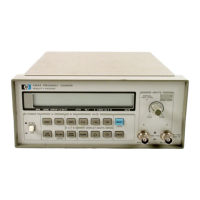~!j:jf;'.
HP 5384A and HP 5385A
" Operat;on and Programm;ng
3-120. Device
independent
commands,
on
the
other
hand,
are
defined
by
the
interface standard
document
and are
the
same in all instruments. These commands
are
identified
by
a
three
letter
mnemonic
such
as
GTL,
which
represents
Go
to
Local. Device
independent
commands
are sent
as
specially
encoded
bytes
on
the
interface and
not
as
ASCII strings. Thus these
com-
mands cannot be sent using
the
OUTPUT statement
on
the
HP-85A.
However,
many
controllers
do
incor-
porate
a
command
of
the
form
SEND7;CMDnnn,
where
nnn
is
the
decimal
equivalent
to
the
bit
pattern
corresponding
to
a
particular
device
independent
command.
3-121. INTERFACE CAPABILITIES
3-122. Since
the
device
independent
commands
are
standardized and are
the
same in all
instruments,
the
functions
these
commands
perform
can be listed
on
the
instrument
in a standardized
manner.
This
is
known
as
the
interface
capability
label.
HP-IB SH1,
AH1,
T5,
TEO,
L4,
LEO,
SR1,
RL
1,
PPO,
DC1, DT1,
CO,
E1
HP-IL
R,
AH,
SH1, D, L 1, (T1,
2,
3,
4,
5,),
CO,
DC2,
DT1,
PP1,
SR2,
AA
1,
RL2,
PDO,
DD1
3-123.
The
number
following
the
interface
function
code indicates
the
particular capability
of
that function.
3-124.
Table 3-5
provides
a list
of
the
interface
capa-
bilities
of
the
instrument.
3-125. META MESSAGES
3-126.
In
order
to
simplify
the
use
of
the
HP-IB and
HP-IL interfaces, HP
has
developed
what
is
called
the
Meta
Message
concept.
Rather than
requiring
the
user
to
remember
all
the
device
independent
mes-
sages
and
their
interactions,
useful sequences
of
these
commands
have
been
integrated
into
a single
command
on
many
of
HP's
controllers.
For
example,
to
clear
the
instrument
at address
03
using
the
device
independent
commands,
it
is
necessary
to
send
the
sequence ATN, UNL,
MTA,
LAD 03,
SDC.In
the
HP-85,
the
command
CLEAR
703
causes this sequence
to
be
sent
with
no
further
user
interaction.
This
greatly
simplifies
the
use
of
the
interface.
3-127.
Many
of
the
meta messages
as
implemented
on
the
HP-85A may
be
sent in
either
of
two
forms,
either
with
or
without
addressing. The
form
with
addressing
will
normally
listen address
the
instru-
ment.
For
example,
the
command
REMOTE
703
will
3-14
Table 3-5. Interface Capabilities
HP-18
HP-IL DESCRIPTION
SH1 SH1
The instrument
can
generate
messages.
AH1 AH The instrument can
interpret
received
messages.
R The instrument can receive
messages.
D The instrument
can
drive
the
HP-IL
loop.
TS
T12345
The instrument can
function
as
a talker.
TEO
L4
LEO
SR1
RL1
PPO
DC1
In addition,
it
can operate
as
a Talker
Only
instrument and can respond
to
serial
poll,
send device ID, and send
accessory ID.
The instrument cannot
function
as
an
extended talker.
L 1 The
instrument
can
function
as
a
listener.
It
will accept commands via
the
interface. In
addition,
it
will untalk
itself
if
addressed
as
a listener.
The instrument cannot
function
as
an
extended listener.
SR2
The instrument can generate a service
request.
In addition,
the
instrument can
generate
an
IDY frame
on
HP-IL.
RL2
The instrument can operate in
both
re-
mote
and local modes.
In
addition,
it
can respond
to
local lockout.
PP1
The
instrument
does
not
support
parallel
poll
on
HP-IB.
On
HP-IL, the
instrument does support
parallel poll.
DC2 The instrument supports
both
the
device clear (DCL) and selected
de-
vice clear
(SDC)
commands.
DT1 DT1
The instrument can be remotely
co
triggered.
CO
The instrument cannot
function
as
a
controller.
AA1 The instrument
can
be remotely ad-
dressed
with
simple (non-extended)
addresses.
PDQ
The instrument cannot be remotely
powered
down.
DD1 The instrument responds
to
the
device
dependent
listener (DDL) command.
E1
The instrument places one load
on
the
HP-IB system.
send
REN
and
then
make
the
instrument
a listener. In
the
following
tables,
the
form
with
addressing
is
shown.
3-128. Table 3-6 lists
the
meta messages,
their
results
in
the
counter,
and typical
interface
message se-
quences
corresponding
to
them.
The sequences are
typical
in
that
different
controllers
may send
different
sequences,
while
still
obtaining
the
same results.
•
•
•

